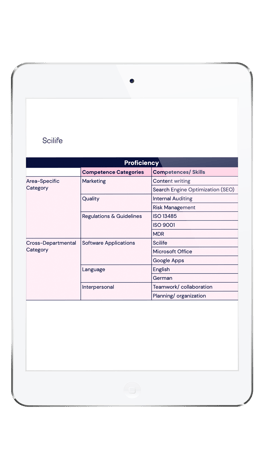
The skills matrix as an HR and project management tool
The skills matrix is one of the core management tools to ensure your success in every project as an employee, as a team, or as a data-driven HR professional. A skills matrix – also known as a competency matrix – is an easy-to-use tool that lets you map out all desired skills for a team or project. Consequently, a well-implemented matrix will help you visualize the skills that are required for your project versus the skills that are readily available in your team. This will enable you to immediately identify the skills that the team is missing to make your project a success.
What can the skills matrix do for you?
For your individual employees
The skills matrix can help employees as an individual and as a member of the team:
-
- As an individual: The matrix shows them what skills they have and what they are missing. This is also a good place to understand personal weaknesses and point out opportunities to improve themselves.
- As a member of the team: The matrix makes them aware of their required skills for the team.
- As an individual: The matrix shows them what skills they have and what they are missing. This is also a good place to understand personal weaknesses and point out opportunities to improve themselves.
For your team
The main role of the skills matrix is to help the team. By applying the tool, the team can have insights on skills that are either present or missing. Required skills can be completed by adding new members who have those missing skills.
For your organization
By applying the skills matrix to the whole organization, you can get an overview of the current competences of your organization. An HR professional can establish an effective improvement plan according to the gaps so that your organization can succeed and achieve greater goals. Also, knowing who is who can give you the flexibility to transfer internal talent to the positions it’s most needed.
7-step process of implementing a skills matrix
1. Identify required skills
The first and foremost step of putting a skills matrix in place is to define all relevant skills/competences for a project or department.
Typically, a department manager and/or HR manager define the required and nice-to-have skills (if any) for the project or the department. You should consider various skills across all areas that you expect from your team to achieve the project. Note that you will assess your team members according to skills that you’ve defined, so think broadly and wisely and try to foresee the future of the project.
The number of competences that you need to define can vary by organization, project, and department. However, competences might be between 10 and 20 in number and can cover job-related skills, knowledge, and behavior in both area-specific and cross-departmental categories-
Additionally, you can add a short description of what is expected from that competency, which allows you to clarify the expectations both from the manager and the employee.
2. Identify proficiency levels
Before starting the assessment process, you should define levels for the relevant skills. You can designate one set of proficiency levels for all skills or various sets of proficiency levels that are designed for each specific skill
There is more than just one way to measure proficiency. You can define your own set of proficiency levels to assess skills that suit best within your organization. Proficiency levels can be categorized into five generalized levels as below:
|
Proficiency Level |
Definition |
|
|
1 |
Novice |
No experience or knowledge |
|
2 |
Advanced Beginner |
Little experience or knowledge |
|
3 |
Competent |
Reasonable experience or knowledge |
|
4 |
Proficient |
Considerable experience or knowledge |
|
5 |
Expert |
Expert experience or knowledge |
3. Assess team members
Once you have a well-defined skills matrix and set of proficiency levels, now you can assess your team members’ skill levels in a clear, consistent way without bias. Assessment can be done in a one-to-one meeting with the team member by asking them to self-evaluate their level for each skill. If the skill needs to be assessed in a systematic way such as language level, you can designate a proficiency exam for that skill.
4. Evaluate results and act
It is time to read between the lines. You know which skills and what levels your employees have. The outputs of the assessment can show you how your team meets the required levels. You can plan your actions according to the results. Results might show if your team has the required level of skill set or needs to improve to achieve the required level.
You should be able to identify learning opportunities and make them available to your employees. Keep reading to learn how to build and improve the skills your employees need to succeed.
5. Create training sources
As a manager and/or HR professional, you can determine the training needs for every employee and create training sources using outputs of the evaluation. You need to have a strong understanding of the current skills that the employee possesses. Then, you can plan a training program to bolster current skills and build new skills. You can assess the progress periodically (e.g., annually), both manager and employee can track their goals with solid metrics and commit to build them within a certain timeframe.
Through the Scilife platform, you can also plan a training program. To keep things as hands-free and automated as possible, the competences tool can be integrated with our Scilife training feature. That means certain competences can be updated in real-time depending on the type of training your employee completes. If you prefer to do things manually, like assigning a manager to update employee skills, or even leaving it to the employee themselves, there’s options for that too.
6. Design a path to guide the process for employees and managers alike
Through the Scilife platform, you can also plan a training program. To keep things as hands-free and automated as possible, the competences tool can be integrated with our Scilife training feature. That means certain competences can be updated in real-time depending on the type of training your employee completes. If you prefer to do things manually, like assigning a manager to update employee skills, or even leaving it to the employee themselves, there’s options for that too.
The key to success to improve skills and build new ones is effective communication. As an HR professional, you can encourage both managers and employees to tackle the progress and learn new skills. You have created training sources that are tailor-made for that team and employee. However, you should also have open communication for any kind of training request that might come from employees. And ask managers to have open communication as well. This way, employees can engage in progress by contributing to the training plan to meet their personal career goals.
7. Set clear expectations and document progress
Employees and managers can create development plans, set expectations, track progress, and monitor results. Just set your goals with solid metrics and review the plan at least annually together with your employee. During the annual review, don’t forget to update your skills in the Competences feature
Free skills matrix template
Here is a skills matrix example that is based on area-specific categories with a couple of example skills. You can define skills that are required for any specific job or department.
 |
Define the required skills for a specific project with our template.
|
The job skills matrix as an HR tool for the hiring process
Start using the skills matrix from the beginning. The key is to have a well-defined job skills matrix that includes all required skills for the specific job. Once you have the job skills matrix, HR and relevant department managers can generate spot-on interview questions. HR can assess a candidate's skills effectively and find the best candidate for the position and for the team.
Knowing the required and nice-to-have skills for a job is a good starting point; however, a skills matrix can and should be used throughout the employee’s business life.
Conclusions
Can you cook a dish without knowing what you have in your fridge? Of course not. This is exactly the same situation!
When you decide to cook, the first thing is to check what ingredients you have in your fridge. If you’ve already decided what to cook, you look at the list of ingredients and tools that you need. And if you don’t have one or more of the ingredients or tools, you won’t succeed and end up with one of these options:
You can cook the dish despite the missing ingredients, but the taste would not be ideal.
Or you can’t cook it at all.
Now, think about the competences that your team has and what competences you need to succeed with your project work. A well-established skills matrix can give you a head start and is also an opportunity to improve your team!
How Scilife can help
A well-established skills matrix can help your company and your team to find out who’s capable of doing what. By knowing this, you can improve your team and achieve greater goals. The Competences Feature on the Scilife Platform allows you to establish and track everything automatically:
- Follow envolving employee abilities
- Sort competences into categories and set skill levels
- Compile a list of relevant skills or competences
- Update competences whenever you want - automatically or manually
- Discover the ideal person for every job, in-house
- Keep employee CVs up to date and easily accessible
- Easily import, export, or print any CV in standardized formats
- Search for employees using multiple competences and levels
- Define your own levels of competences or use our preset levels
Get to know more about Scilife Competency Management Software



